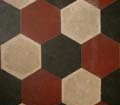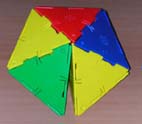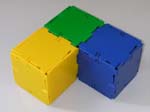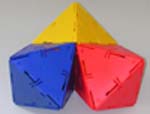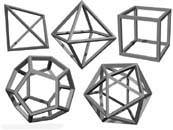
If we want to make a regular polyhedron, we start up with regular polygons that are all alike. We assemble them around a vertex so that there is a gap, in the plane. In other words, the sum of the angles around the vertex is less than 360°.
It is exactly this gap that allows closing up the polygons in three-dimensional space; so we obtain a convex polyhedron. If the sum of the angles were equal to 360°, we would obtain a plane tasselation).
That's the reason why the regular polyhedra can not be more than five. Indeed, the possible combinations are five: 3 by 3 pentagons, 3 by 3 squares, 3 by 3 triangles 4 by 4 triangles or 5 by 5 triangles.
Clearly, in order to be sure that the regular polyhedra are exactly five, we should prove that each combination around a vertex can be carried out with the same pattern so to obtain a polyhedron.
Let us try to mimic this argument in higher dimension, i.e., let us try to make a polytope in four-dimensional space. We can start to choose a regular polyhedron and then try to assemble various copies of this polyhedron, all alike, around an edge. As before, we need a gap (this time in three-dimensional space). In other words, the sum of the dihedral angles at an edge must be less than 360°; As for the polygons that come up in a polyhedron, this gap will be responsible for closing up the polyhedra in four-dimensional space; so we will get a convex polytope. If the sum of the dihedral angles were equal to 360°, we would obtain a space tessellation. For example, think of four cubes around an edge.
Also in this case there are not too many possibilities. If we start with regular tetrahedra, we can assemble them 3 by 3 or 4 by 4, or 5 by 5, and not more. In fact, the dihedral angle of a tetrahedron is greater than 60° and smaller than 72°.
|
If we start with cubes, we can assemble them 3 by 3 and not more because the dihedral angle of a cube is 90 degrees. If we use four cubes, we will tessellate the space.
|
|
|
If we start with regular octahedra, we can assemble them only 3 by 3
because the dihedral angle of a regular octahedron is greater than 90°(and smaller than 120°). |
|
|
If we start with regular dodecahedra, we can assemble them only 3 by 3 because the dihedral angle of a regular dodecahedron is greater than 90° (and smaller than 120°).
|
If we start with regular icosahedra, we can not assemble them even three by three because the dihedral angle of a regular icosahedron is greater than 120 degrees. There are at most six possibilities. In fact, one can prove that each of these combinations can be repeated with the same pattern so to obtain (in four dimensional space) a convex polytope:
- the hypertetrahedron which is made up of 5 tetrahedra (three at each edge);
- the hyperoctahedron which is made up of 16 tetrahedra (four at each edge);
- the 600-cell which is made up of 600 tetrahedra (five at each edge);
- the hypercube which is made up of 8 cubes (three at each edge);
- the 24-cell which is made up of 24 octahedra (three at each edge);
- the 120-cell which is made up of 120 dodecahedra (three at each edge).

